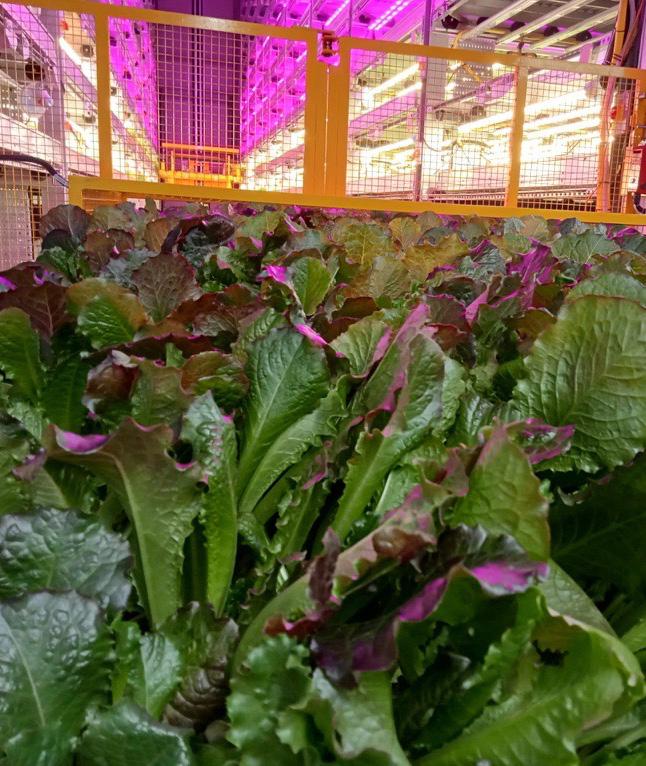
4 minute read
Gresham House ~ The Future of Farming
Vertical Farming will help to feed a soaring human population
A planet in peril
Advertisement
Today, we struggle to feed all of humanity and minimise our environmental impact; and, as the population continues to grow, we threaten to overwhelm our planet. In the last 40 years alone, 800m hectares of forests have been cut down related solely to food production, this is the equivalent of the size of Australia. Vertical Farming uses otherwise unproductive land – and massively increases yields –and will ‘load-balance’ food production by freeing up arable land for crops that cannot be grown in this way.
Non-renewable resources under threat
Conventional farming needs good land and water, both of which are disappearing. The best land is near rivers where people congregate and where towns and cities develop; and there is a very large amount of good land being concreted for buildings, factories, roads and car parks. That displaces farming to poorer-quality soils and natural habitats. Those soils are more prone to erosion leading to losses of massive quantities of topsoil which is required for 95% of food production, with estimates suggesting we only have 60 years of topsoil left at current erosion rates.
Water is also becoming a major issue. 25% of global food production comes from aquifer water, which takes thousands of years to recharge. Most of that will be gone in the next few decades. A large percentage of the remaining water comes from river irrigation systems, which is also running out due to too much agriculture and erratic rainfall. This is causing many rivers to run dry and not even reach the sea. Finally, rain-based monsoonal farming, such as practiced in India, South East Asia and Southern China, are becoming more volatile with crops failing regularly due to lack of rain. Droughts have killed more people than any other natural disaster over the last 50 years, with 90% of these deaths occurring in developing countries.

Red Batavia grown at Fischer Farms’ Farm 1 in Staffordshire
Impact on the natural world
The impact on the natural world is even more dramatic. Humans are causing mass extinctions around the planet. This is directly linked to human population growth, the growth of cities and the destruction of the natural world for farming, mining, forestry products and overfishing with estimates that by 2048 there will be no more fish in the sea.
Fischer Farms: the future of farming
We first invested in Fischer Farms in 2018. The business produces high-quality leafy greens at a vertical farm based in Burton-onTrent, UK.
These farms use very little land as they grow vertically, and they get significantly more harvests per year out of the same space. For every acre of land that Fischer Farms occupies, you would need 250 acres of conventional farmland to produce the same amount of food.
They use 95% less water than required by field-grown crops: once their closed system is charged, water is recycled, so the only water they lose is in the cell structure of the plants they sell.
Their facilities can be sited on flat land of any quality, meaning they don’t need to encroach on the habitats of the animals with whom we share our planet and provide food security with the ability to grow 12 months of the year.
We recently appointed carbon consultants to analyse the carbon and wider environmental benefits of Fischer Farms’ second farm that is being developed. The analysis highlighted some material environmental benefits vs. traditional farming methods
including:
▲ 99% reduction in land required to produce the same yield as conventional farms
▲ <1% of the water-related emissions generated by conventional farming to grow the same yield
▲ 1,900 x less greenhouse gas emissions per tonne of produce compared to imported crops from Mexico
▲ 14-21 day shelf life extensions which drastically improve food waste and reduce the amount of plastic packaging
Medium term, vertical farming will look to grow soy, wheat and rice to allow the drastic reduction of deforestation and allow for creation of plant based proteins. Given the world’s cattle alone consume the caloric needs of 8.7 billion people - more than the entire human population on Earth - enabling low-carbon meat alternatives must be good for the planet
This is the future of farming. Ultimately we believe it to be the future of food. It is not just exciting. It gives us hope.
Sources
1 www.theguardian.com/globaldevelopment-professionalsnetwork/2017/jan/23/ destroying-rainforests-quicklygone-100-years-deforestation
2 www.greenpeace.org/usa/ forests/issues/agribusiness/
3 www.theguardian.com/usnews/2019/may/30/topsoilfarming-agriculture-food-toxicamerica
4 www.businessinsider.com/ un-droughts-killed-most-peoplein-worlds-worst-disasters-2021-9
5 www.theworldcounts.com/ challenges/planet-earth/oceans/ overfishing-statistics
6 www.peta.org/about-peta/faq/ how-does-eating-meat-harmthe-environment/








